How I’ve improved my remote presentation setup
When I wrote Demystifying Public Speaking, I based nearly all of my research and advice around how to brace yourself for, and give, in-person presentations. And for the first three years of being a self-employed trainer and coach at Wherewithall, 90% of my presentations were in-person: at company offices, conferences, and meetups.
Then the pandemic hit. I was lucky to have a trusted advisor to lean on as I adapted my workshop content to work better for a fully-remote audience, and for my own brain. But even though I’d successfully revamped my content, I still needed to iterate on the quality of and environment for my remote presenting setup.
Desk setup
As I iterated on my physical setup, I optimized for two things:
- What worked best with my personal public speaking preferences and workflow.
- What looked best to an audience.
Since I’m self-employed, I can write off office purchases as business expenses. This means that I did not optimize for overall cost savings. I hope this list of tweaks and tools helps you think about your own setup (and what YOU want to optimize for!) if you also find yourself giving remote presentations a lot.
(And none of the links to products I’ve included below are sponsored—I’m sharing the stuff I truly use every day, because they work for me!)
Faking eye contact with the audience
I use my laptop’s built-in FaceTime camera for all of my talks, since the quality is fine and I’ve gotten used to aligning its height with my eyeline. At this stage, I’m practiced at appearing like I’m making eye contact with my audience over video.
But as much as I’d like to be the kind of presenter who can improvise, I’m not—which means I use a script or presenter notes for every prepared event.
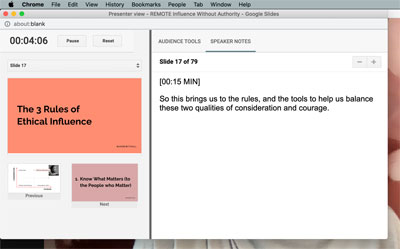 For easy referencing, I put my presenter notes or a short text file with the script just underneath that camera, so I can glance at it as needed, and it doesn’t look like I’m looking away to read it! I keep the window short and the font size huge so I can just scroll through it, rather than looking further down as I read.
For easy referencing, I put my presenter notes or a short text file with the script just underneath that camera, so I can glance at it as needed, and it doesn’t look like I’m looking away to read it! I keep the window short and the font size huge so I can just scroll through it, rather than looking further down as I read.
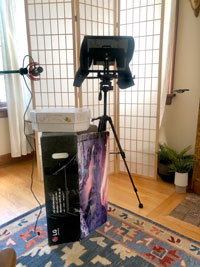 And when I was recording my self-paced video program last summer in my living room, I learned how easy it is to use a mirrored teleprompter (mine was $165 from Caddie Buddy). You place your phone or tablet in the base, use a teleprompter app to mirror the text and auto-scroll at your desired speaking pace, and voila! A handy teleprompter.
And when I was recording my self-paced video program last summer in my living room, I learned how easy it is to use a mirrored teleprompter (mine was $165 from Caddie Buddy). You place your phone or tablet in the base, use a teleprompter app to mirror the text and auto-scroll at your desired speaking pace, and voila! A handy teleprompter.
For those recordings, I used a DSLR instead of my computer—but you can use a teleprompter with your webcam too! Check out Anjuan Simmons’ setup.
Lighting
I already knew how important it was to not be backlit, and to avoid any bright lights or windows behind my head. If it had been possible to face a window or another soft light so that my face could be well-lit, I would have—but my office has a south-facing window, and one dim overhead light.
Many folks recommend getting a ring light for their Zoom call/presentation setup, but those sadly don’t work for me—my glasses always reflect the ring!
I did a ton of research online to see how other people avoid lighting setups reflecting in their glasses, but didn’t come up with any truly workable solutions. I was reluctant to invest in studio lights and softboxes (there isn’t that much space in my office), and I didn’t want to use tricks like hairspray on my glasses. I resorted to asking Twitter, and my friend Bea introduced me to the world of Twitch streaming setups, and Elgato lights.
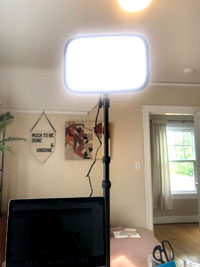 I now use an Elgato key light ($200) behind my computer, raised up to roughly two feet above my head and slightly off to one side. Its diffuse light is perfect for lighting my face without creating lots of shadows, and without reflecting in my glasses.
I now use an Elgato key light ($200) behind my computer, raised up to roughly two feet above my head and slightly off to one side. Its diffuse light is perfect for lighting my face without creating lots of shadows, and without reflecting in my glasses.
If my desk faced a wall, I would also have tried a tip I learned from that research: turn your lamp to face your wall, so that the light bounces off the wall and diffusely lights up your face. Brilliant.
Though the Elgato key light comes at a high price point, it’s worth it to me because—in addition to solving my glasses reflection problem—I can control the brightness and color of the light from my computer. In late afternoons or dreary days when I need more light in the office, I turn it up, and when I’m wearing a bold color that throws off the video’s white balance, I adjust the color temperature of the light to compensate.
Screen sharing
I’d been hesitant to get a second monitor, for space reasons; I’d only need it when it was time to give a presentation, since the rest of the time I’m coaching or writing and don’t need the second monitor. I’m the kind of person who can’t work around lots of clutter, and I need copious space for note taking, so for a long time I simply shared my Google Slides presentation from a separate window on my laptop (rather than a full-screen screenshare).
I knew this wouldn’t be workable long-term. If I ever wanted to use Keynote or PowerPoint for a particular talk, I’d need to have two screens: one for the slides, and one for my notes. And some video conferencing software doesn’t provide an option to share just one application window.
After researching portable monitors, I ended up deciding to invest in an iPad Pro. While it’s significantly more expensive than a normal second monitor would be, it met my reduced footprint needs; I can easily close it up and move it off my desk when I’m not giving a talk. It’s also tremendously easy to set up as a second screen from my Mac, and I now use it instead of carting around my laptop when I want to do some work or reading from another room.
Audio
Eons ago when I started coaching remotely, I bought a $25 Logitech USB headset. I would joke on calls that I looked like air traffic control, but it honestly has been exactly what I’ve needed: noise canceling, not-too-pinchy on my head, and crystal clear for those on the receiving end.
I’ve considered switching to an external microphone (the more expensive Blue Yeti, and the Rode microphone I used to film my video course, have both gotten great reviews), but honestly? I move around enough when I’m animatedly talking and presenting that I much prefer using a microphone attached to my head. And the A/V folks I’ve worked with on a variety of remote conferences have, unprompted, said it sounds (surprisingly) great.
One podcast graciously sent me a Sennheiser single-ear headset to use for our recording, but honestly I found it incredibly distracting to be able to hear other noise happening in my house! So I’ve stuck with my reasonably-priced Logitech H390 throughout this whole journey, and it’s been perfect.
Wall backdrop
This improvement was the second-most expensive change I made to my setup (after the iPad pro): I purchased a peel-and-stick wall mural for the wall behind my head.
Having a non-distracting background is important for remote presentations, but my previous background took it to the extreme: an off-white painted wall with nothing else on it. I had experimented with different office configurations so that I could have chill art, an organized bookcase, or calming plants behind me, but I ended up being constrained by power outlet locations in the room.
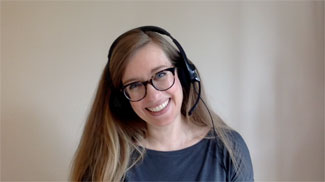 My wall color was bland, and I was nervous to paint it a new color; depending upon my lighting setup and time of day, my bookshelf (and my waving hands) casted distracting shadows in the background, and I didn’t want to risk getting a paint color that would dampen the limited daylight my office already gets.
My wall color was bland, and I was nervous to paint it a new color; depending upon my lighting setup and time of day, my bookshelf (and my waving hands) casted distracting shadows in the background, and I didn’t want to risk getting a paint color that would dampen the limited daylight my office already gets.
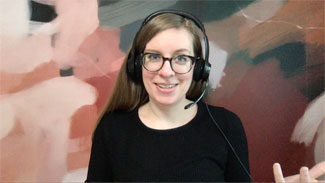 So I purchased a removable wall mural as an experiment. I chose an abstract pattern that’s very gentle and coordinated with Wherewithall’s brand colors. It was stressful to align all of the panels—just like normal patterned wallpaper is!—and because parts of the wall are less-insulated, some areas routinely peel up on colder days. I’ve developed a new ritual of smoothing out air bubbles a few times a week; it’s nearly meditative. :)
So I purchased a removable wall mural as an experiment. I chose an abstract pattern that’s very gentle and coordinated with Wherewithall’s brand colors. It was stressful to align all of the panels—just like normal patterned wallpaper is!—and because parts of the wall are less-insulated, some areas routinely peel up on colder days. I’ve developed a new ritual of smoothing out air bubbles a few times a week; it’s nearly meditative. :)
But honestly? In spite of those frustrations, the addition of the abstract mural behind me has made the largest positive impact to my remote presentation setup. It hides shadows cast from my bookcase and my gesticulations, highlights me, and is visually interesting without being a distraction. A number of folks have asked if it’s a Zoom background. If you’re looking for a solution to your video call background—or want to avoid having to tidy everything behind you before you hop on an important call—I recommend you consider getting one!
Tech setup
So that covers the physical space changes. What about the digital aspect of remote presenting?
Back it up
I included a section on how to back up your presentation in my book Demystifying Public Speaking:
“No matter how confident you are that you’ll be able to use your own equipment onstage, prepare for that just in case moment when you’ll need to use someone else’s machine.”
Well, this unfortunate event can happen in a remote context, too :)
I recently gave a talk at an internal event for a Fortune 50 company, and their presentation software had a new bug that wasn’t there the day before during our tech check: they could no longer see my video and my slides at the same time.
With ten minutes to go before I went virtually “onstage,” I suggested that I send their A/V team my backup presentation file, so that they could screenshare the slides while I spoke. My file’s presenter notes included my script, so their team could follow along and advance the slides as my words matched up.
It (mostly) worked! But unfortunately I hadn’t followed every bullet point of my own guidance from Demystifying Public Speaking:
“To avoid this pitfall (and major spike in stress), I suggest two safeties. One, create a backup folder of your files and save it to a physical thumb drive. Two, save the folder online in whatever service you prefer (I use Dropbox) and email the link to yourself. This way, you can quickly forward that link to someone else, if they need your files. Your backups should include:
- Your original slide deck (PowerPoint file, Keynote file, HTML, etc.)
- Any fonts used in your presentation
- A PDF of your slide deck without notes, so if another person’s laptop can’t run your original deck, you can still show your PDF as slides (though animated GIFs and videos won’t work)
- A PDF of your slide deck with notes, so you can reference them from a tablet or phone if necessary”
Because I shared the presentation file but not the fonts, some slides were nearly illegible with their computer’s replacement fonts. I shared the PDF of the slides afterwards with all attendees, so at least they eventually knew what the slides should have looked like. ;)
Recording video with your computer
Occasionally, I don’t present live, and instead need to record video. For the video training course, I recorded Zoom calls with colleagues to model different leadership skills. But after some testing I knew that Zoom’s recordings wouldn’t cut it on quality. They looked grainy, any wifi blips meant a blip in the recording, and the audio wasn’t great.
So I decided to record with Quicktime instead. Here are my setup tips for recording yourself using the quality settings built into a Mac:
- Quicktime settings: Create a new Quicktime Movie file with these settings (which you can find with the dropdown to the right of the red start button):
- Quality: High (not maximum)
- Microphone: Choose the microphone in your headset (or if you have a separate mic, like a Blue Yeti, choose that!)
- Move the volume control all the way to the left
- Lighting: Make sure there’s no bright lights or windows behind your head. If you can face a window or light (so that your face is well-lit), that’s great!
- Background: Neutral walls, art, tidy bookcases, etc. are all fine! You just want to avoid grabbing the viewer’s attention with something other than your face (like words written on a whiteboard behind you).
- Microphone: any headphone mic or non-laptop mic will do! You’re just trying to isolate your voice and cut down on background noise seeping in.
Presentation-wise, all of my remote conference talks have been with A/V teams who decide how my slides and face will appear for the audience. If in the future I want to create my own slides-and-talking-head-video, I’ll try testing out the app Mmhmm.
Oh and if you’re doing video-based internal comms for your distributed team? I recommend you check out the app Breve. I’ve used it and I love it.
Recording video with a DSLR
I used to be a wedding photographer in a previous life, and held onto a bunch of my old equipment. For the video training project, I used an ancient DSLR that still works and can record video.
If you’re going the extra mile and want to step away from your computer to record a talk, I recommend investing in a mirrored teleprompter like the one I mentioned earlier, and an external microphone. Some people love lavalier microphones; I’ve found that I move my head around too much and risk my long hair brushing up against them! For the video training course, I used a Rode shotgun mic on a stand, just offscreen.
The biggest challenge: the lack of audience feedback
All of that setup stuff aside, the biggest difference to me about presenting remotely has been being unable to see or hear my audience.
Here’s a section from Demystifying Public Speaking about reading your audience:
“In my early talks, I didn’t hear laughter—not because the crowd was silent, but because I was too nervous and focused on my delivery to notice anything else. These days, I’m able to devote more brain space to reading the room (and registering laughs at my jokes). I can take stock of nods, ‘ahs’ of understanding, and whether people are leaning toward me to listen intently.”
This spidey sense took patience and experience to develop, but it’s useless if you can’t see or hear the audience. When I’m hosting a remote workshop now, I encourage people to keep their cameras on, because I lead lots of interactive exercises with a group. But for remote talks? There’s no good reason for people listening to keep their cameras on!
It’s important to me that folks listening remotely are able to keep their cameras off, if they’d like to. It’s a privacy issue, and it can also free them up to listen while taking a walk or caretaking for someone else in their house. And in larger dial-in events, it’s impossible to see your audience anyway.
So, whenever it’s possible, I ask one person who will be attending the event to be my camera-on buddy. I’m fortunate to know enough people at these events or at these companies that I can ask them if they’d be game to listen in and keep their camera on, so I can have just one cheerleader there in the otherwise-invisible crowd. I glance at them and am always encouraged if I see them nodding or grinning while listening to me present.
If you aren’t close enough with any individuals to ask for their help with this, try this brilliant approach from a professor:
“I gave them my best estimates: that when less than 1/3 of students had their cameras off, there was no impact on my teaching. That I could feel a significant worsening at 1/2. And that once it got above 2/3 cameras-off, I felt wholly cut-off and unable to be responsive.
“The result this term: my classes are staying mostly below 1/3 cameras-off. No policy, no further comments from me, no enforcement or pleading. And I think it’s a bit self-regulating - sometimes the % of cameras-off drifts up, and then a few students will turn their cams back on.”
If you’re listening to a remote speaker and want to especially support them, turn your camera on! I know it’s not always possible—but when it is, it makes all the difference.
Costs
In the interest of transparency!
Total remote presentation setup improvement costs
- Elgato Key Light: $200
- iPad Pro: $900
- Logitech ClearChat Comfort/USB Headset H390: $25
- Minted removable wall mural: $360
Additional costs for the video training course recording setup
- Caddie Buddy Teleprompter: $165
- Rode VideoMic NTG On-Camera Shotgun Microphone: $250
- My ancient Canon 5D MkII DSLR: Technically free